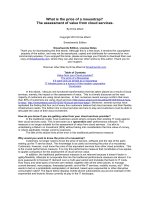The price of climate action
Bạn đang xem bản rút gọn của tài liệu. Xem và tải ngay bản đầy đủ của tài liệu tại đây (1.63 MB, 152 trang )
THE PRICE OF CLIMATE
ACTION
Philanthropic
Foundations in the
International
Climate Debate
Edouard Morena
The Price of Climate Action
Edouard Morena
The Price of Climate
Action
Philanthropic Foundations in the International
Climate Debate
Edouard Morena
ULIP and CNRS-LADYSS
Paris, France
ISBN 978-3-319-42483-5
ISBN 978-3-319-42484-2
DOI 10.1007/978-3-319-42484-2
(eBook)
Library of Congress Control Number: 2016952868
© The Editor(s) (if applicable) and The Author(s) 2016
This work is subject to copyright. All rights are solely and exclusively licensed by the
Publisher, whether the whole or part of the material is concerned, specifically the rights of
translation, reprinting, reuse of illustrations, recitation, broadcasting, reproduction on
microfilms or in any other physical way, and transmission or information storage and retrieval,
electronic adaptation, computer software, or by similar or dissimilar methodology now
known or hereafter developed.
The use of general descriptive names, registered names, trademarks, service marks, etc. in this
publication does not imply, even in the absence of a specific statement, that such names are
exempt from the relevant protective laws and regulations and therefore free for general use.
The publisher, the authors and the editors are safe to assume that the advice and information
in this book are believed to be true and accurate at the date of publication. Neither the publisher nor the authors or the editors give a warranty, express or implied, with respect to the
material contained herein or for any errors or omissions that may have been made.
Printed on acid-free paper
This Palgrave Macmillan imprint is published by Springer Nature
The registered company is Springer International Publishing AG Switzerland
To Anabella and Inès
ACKNOWLEDGEMENTS
Firstly, I would like to express my sincere gratitude to all those from within
the foundation and NGO community who took the time to share their
experience and thoughts on the issues raised in this book. My sincere
thanks also go to those who read and commented earlier versions of this
book and in particular to Laura Martin Murillo. I would also like to thank
my colleagues from the ClimaCOP team for their invaluable advice, stimulating research and collective wisdom.
Last but by no means least, my love and thanks go out to my friends
and family, and in particular Anabella and Inès.
vii
CONTENTS
1 Introduction
2
1
Philanthropic Foundations and the International Climate
Regime
23
3
A Strategic Approach to Climate Philanthropy
41
4
Foundations in Copenhagen
65
5
The International Policies and Politics Initiative
89
6 Conclusion
125
Index
137
ix
LIST
AGGG
CAN
CAT
CBS
CCCM
CCPAN
CCS
CD
CEA
CEFG
CFF
CGBD
CIFF
CJN
CLEW
CLUA
CPI
DDPP
E3G
ECF
ECIU
EDF
EF
EFC
EGA
ESC
OF
ABBREVIATIONS
Advisory Group on Greenhouse Gases
Climate Action Network
Climate Action Tracker
Climate Briefing Service
Climate change counter-movement
Climate Change Philanthropy Action Network
Carbon Capture and Storage
Cartagena Dialogue
California Environmental Associates
Climate and Energy Funders Group
Centre Français des Fonds et Fondations
Consultative Group on Biological Diversity
Children’s Investment Fund Foundation
Climate Justice Now!
Clean Energy Wire
Climate and Land Use Alliance
Climate Policy Initiative
Deep Decarbonization Pathways Project
Third Generation Environmentalism
European Climate Foundation
Energy and Climate Intelligence Unit
Environmental Defense Fund
Energy Foundation
European Foundation Centre
Environmental Grantmakers Association
Energy Strategy Center
xi
xii
LIST OF ABBREVIATIONS
EU
FNTG
FOE
GCCA
GCEC
GSCC
IDDRI
INDC
IPCC
IPPI
LARCI
LDC
NRDC
OCN
OECD
OWINFS
PC
RBF
RFF
SDSN
SIDS
UNEP
UNFCCC
WMO
WRI
WSF
European Union
Funders Network on Trade and Globalization
Friends of the Earth
Global Call for Climate Action
Global Commission on the Economy and Climate
Global Strategic Communications Council
Institut du développement durable et des relations internationales
Intended Nationally Determined Contributions
Intergovernmental Panel on Climate Change
International Policies and Politics Initiative
Latin America Regional Climate Initiative
Least Developed Countries
Natural Resources Defense Council
Open Climate Network
Organisation for Economic Co-operation and Development
Our World Is Not For Sale
Project Catalyst
Rockefeller Brothers Fund
Resources for the Future
Sustainable Development Solutions Network
Small Island Developing States
United Nations Environment Programme
United Nations Framework Convention on Climate Change
World Meteorological Organization
World Resources Institute
World Social Forum
CHAPTER 1
Introduction
Abstract Following a brief presentation of the 21st Conference of the
Parties (COP21) outcome and reactions to it, the chapter introduces
some of the core theoretical debates associated with the study of philanthropic foundations’ involvement in the international climate debate.
It looks at how the existence of underlying agendas in foundations raises
important legitimacy and accountability concerns. The chapter also analyses philanthropic foundations’ broader societal functions—and in particular their role as field-builders. In a final section, it presents the main issues
raised by the book—to what extent and how did foundations shape and
orientate the United Nations Framework Convention on Climate Change
(UNFCCC), and international climate regime more broadly? And correspondingly, what influence did foundations wield on the Paris outcome?—
and offers an overview of the different chapters.
Keywords Climate philanthropy • Social movement funding •
Philanthrocapitalism • Venture philanthropy • Strategic philanthropy
On the Monday that followed the adoption of the Paris climate agreement, a majority of the world’s newspapers were unequivocal in their
celebrations of a “historic pact,” a “historic deal,” a “landmark climate deal,” “a ground-breaking climate accord,” a “chance to save the
© The Editor(s) (if applicable) and The Author(s) 2016
E. Morena, The Price of Climate Action,
DOI 10.1007/978-3-319-42484-2_1
1
2
E. MORENA
world.”1 A few hours earlier on the evening of December 12, 2015 at
7.23 pm, the packed assembly hall in Le Bourget was engulfed with an
overwhelming sense of euphoria as Laurent Fabius, the French foreign
minister, brought down the gavel to officially mark the agreement’s
adoption. Images of Fabius with tear-filled eyes and of delegates cheering, clapping and embracing each other were broadcast live around the
world. After four years of arduous negotiations, 195 countries had finally
agreed to a deal that committed them to collectively limit global warming to “well below” 2 ºC over pre–Industrial Revolution levels, to peak
climate-changing greenhouse gas emissions “as soon as possible” and to
review national mitigation targets every five years beginning in 2023.
For UN Secretary General Ban Ki-moon, the 21st Conference of the
Parties (COP21) agreement marked the world’s entry into “a new era of
global cooperation on one of the most complex issues ever to confront
humanity. For the first time, every country in the world has pledged to
curb emissions, strengthen resilience and join in common cause to take
common climate action” (UNFCCC 2015). As he then added, “this is a
resounding success for multilateralism” (UNFCCC 2015). Echoing most
of the World’s leaders, François Hollande, French president, praised the
agreement as a “major act for humanity” (RFI 2015).
On the side of the numerous non-state actors campaigning for climate action, reactions to the agreement were far less unanimous. While
Greenpeace International hailed the fact that “today the human race
has joined in a common cause,” Avaaz labelled the agreement “a turning point in history” and CARE International welcomed the fact that
“all countries promise not to leave the poor behind,” others were less
enthusiastic (Voorhaar 2015). At a press conference on December 12,
convened by representatives from the climate justice community—Third
World Network, LDC Watch, Friends of the Earth USA, Asian Peoples
Movement on Debt and Development—Asad Rehman from Friends of
the Earth International described a “Titanic scenario” where the “ship is
sinking and the band plays on to the warm applause of our political leaders […] and the poor are being denied a place in the lifeboats” (Friends of
the Earth International 2015). For Kate Lappin of the Asia Pacific Forum
on Women, Law and Development, “this deal does not deliver climate
justice: Justice requires accountability, responsibility, remedies and action
by the perpetrators. Polluters got another unwarranted good behaviour
bond and more opportunities to profit from climate change” (Carbon
Pulse 2015). Outside of the negotiation space, a number of grassroots
INTRODUCTION
3
organizations also expressed strong reservations towards what they saw as
an unjust and inadequate agreement.
In between these two positions were a number of more nuanced reactions. While welcoming the deal’s global character and its ambitious target, many pointed to its vagueness when it comes to securing the means
of implementing and reaching its stated goals. Others criticized the fact
that developed countries were not doing their fair share of efforts through
the deal. For Harjeet Singh, global lead on climate change with Actionaid
International, “what we needed out of Paris was a deal which put the
world’s poorest people first […]. Yet what we have been presented with
doesn’t go far enough to improve the fragile existence of millions around
the world. Despite disappointment, the Paris agreement provides an important hook on which people can hang their demands” (Voorhaar 2015).
Within the climate community gravitating around the United Nations
Framework Convention on Climate Change (UNFCCC) space, one group
in particular was especially satisfied with the Paris outcome. The members
of this group were not just satisfied with the agreement but with themselves. They were convinced that they had played a pivotal role in the Paris
success. Cutting across a variety of organizations and interests, this group
of activists, consultants, business representatives, policy analysts, public
figures, climate experts, communications and media specialists, and data
analysts worked together—and often in collaboration with the UNFCCC
and Parties to the negotiation—in the months and years leading up to
COP21 to create the conditions for a “successful” Paris outcome. Late
into the evening of December 12, at the Climate Action Network (CAN)
International celebratory event in central Paris, members of this highly
qualified and experienced network of individuals were celebrating not only
the agreement but also their contribution to its realization. As they sang
along to Queen’s “We are the Champions!” they had themselves in mind.
This was their moment. This was their agreement.
Three main characteristics set this group apart from other actors and
groups of actors involved in and around the UNFCCC process. First of
all, the group’s specificity stems from the heterogeneity of its members and
the fact that it breaks pre-existing, non-state actor typologies in the climate field. Drawing on Peter Newell’s typology of groups in the climate
debate and their strategies, we can say that the group in question combines elements of the “inside-insider,” “inside-outsider” and “outside-outsider” categories (Newell 2005, 114).2 While its members are formally part
of the Observer3 category, many of them have developed close working
4
E. MORENA
relations with UNFCCC officials, national delegates and government
representatives. Whereas Newell broadly associates each group with a given
strategy and ideology, in the group at hand, members tactically align their
respective action repertoires for the purpose of an overarching and mutually agreed objective. Through their interactions and shared meaning systems, they form an organizational field that brings a number of different
actors “into routine contact with one another under a common frame of
reference, in pursuit of an at least partially shared project” (Bartley 2007,
233; Minkoff and McCarthy 2005). In addition to forming an organizational field, they constitute an informal community of individuals; individuals who, in different capacities, have a long experience of monitoring and
engaging in the UNFCCC process (negotiators, non-governmental organization [NGO] representatives). In other words, while keeping with their
organizational specificities, they devise ways of collectively working towards
a pre-determined outcome in Paris. In some cases, this involves finding
ways of getting their respective organizations to adjust their strategies in
accordance with the overall group strategy.
Members of this group were bound by a common yardstick for measuring success in the Paris climate negotiations. Broadly speaking, this
included three items—that would ultimately be included in the final Paris
agreement: a long-term goal, a mechanism to regularly review and ratchet
up national mitigation and financial commitments and, finally, a global
framework to ensure transparency (Morgan 2015). These criteria confirm
the international climate regime’s shift away from a top-down, multilateral and legally binding approach to international climate governance to a
more bottom-up approach centred on national commitments.
The second major characteristic of this group is its participants’
shared “roadmap” for success. This involves, as was previously suggested, coordinating actions at multiple levels and locations, as well as
engaging with a wide range of actors in order to not only generate the
conditions for an agreement but also ensure that it is suitably interpreted
in the media and society at large. It also means getting their respective
organizations and constituencies to buy into the strategy—or at least
not get in the way. By focusing on not just the content but the interpretations of the agreement, the belief is that an optimistic and galvanizing
message leading up to and coming out of Paris will catalyse ambitious
action on behalf of state and non-state actors. Hence, the need for Paris
to send “unambiguous signals that the world will shift its economic and
social activity toward more climate-friendly and sustainable pathways”
INTRODUCTION
5
(Oberthür et al. 2015, 1). The signals become just as important as the substance of the agreement. As Laurence Tubiana, lead negotiator for France
and chair of the European Climate Foundation, candidly explains in a postCOP interview for Libération: “We had to anticipate the interpretation of
the agreement. Words contribute as much to change as the agreement itself:
it is what I call the convergence of rational anticipations.” As she adds, “the
agreement has to be a self-realizing prophecy” (Losson 2015).
A third and final characteristic of this group is that most of its members
were either directly involved in or associated with the International Policies
and Politics Initiative (IPPI). Set up in 2013 by five philanthropic foundations—European Climate Foundation (ECF), ClimateWorks Foundation,
Oak Foundation, the Children’s Investment Fund Foundation (CIFF)
and the Mercator Foundation, IPPI is presented as “a new platform for
philanthropic cooperation to catalyse greater ambition on climate through
activities and processes taking place at an international level” (ECF 2014,
26). It is “designed to help philanthropy identify opportunities for international collaboration, develop joint strategies, and pool and align grant
making to achieve greater overall impact.”4, 5 It acts as a platform where
foundations and grantees meet to strategize on how international political and policy levers can catalyse more ambitious policies at the domestic
level.6 As Jennifer Morgan (World Resources Institute [WRI]), who coordinated the IPPI platform in the run-up to and during the Paris COP,
explains “IPPI is focused on using the ‘Paris moment’ to increase the scale
and pace of change” (Cox 2015, 21).
Launched in 2013, IPPI is not the only case of foundation involvement in the international climate debate. As we will see, there were other
foundation initiatives before it and in parallel. However, IPPI is without
doubt the most elaborate and possibly, given the Paris “success,” the most
effective. Given its influential role in pushing for a certain outcome and
organizing non-state actors in the run-up to and during Paris, IPPI sheds
light on an understudied actor in the international climate regime: the
philanthropic foundation. A rapid overview of funding sources shows
that a significant share of non-state actors involved in and around the
UNFCCC process is either partially or totally reliant on foundation support. As we will see, the source, the nature and the level of foundation
support for climate-related activities vary greatly from one organization to
the next, and over time.
The reliance of so many non-state actors on foundation funding partly
has to do with the high entry costs for those who want to adequately
6
E. MORENA
monitor and hopefully influence the international climate process—
especially in a global context marked by an overall drop in public funding
towards NGOs (Dryzek and Stevenson 2014, 131). More generally, it has
to do with the fact that, as Lipschutz and McKendry explain, “although
civil society groups are assumed to be normatively motivated […] they
are nonetheless embedded in a global capitalist economy and have quite
specific material requirements that must be fulfilled in order to operate
successfully” (Lipschutz and McKendry 2011, 373). As they go on to
explain, “to be successful, an organization must survive and, in a marketbased environment, this means finding ways to generate the funds necessary to sustain operations” (Lipschutz and McKendry 2011, 373). Funds
are required to both finance participation and facilitate lobbying activities—through joint initiatives, platforms, dialogues, reports, campaigns,
outreach activities, and the creation and upholding of informal relationships of trust between NGOs and the UNFCCC secretariat and/or members of government delegations (Caniglia et al. 2015, 241; Caniglia 2001;
Dodds and Strauss 2004).
Funding sources and their influence constitute an important dimension of NGO participation in the global climate regime. And yet, this
aspect is largely absent from the academic literature on climate governance
(Bäckstrand and Lövbrand 2015; Dietz and Garrelts 2014). The available
academic literature focuses almost exclusively on collective and individual
discourses and framings, as well as modes of action—also called repertoires
of action in the social movement studies literature—and opportunity
structures. It pays relatively little attention to the resources—and especially the financial resources—required to engage these actions, let alone
those needed to secure institutional continuity. This leads many observers
to either ignore or underestimate the level and forms of philanthropic
involvement in the international climate debate.
In the vast body of predominantly North American literature on philanthropy, relatively little has been written on climate philanthropy—and
even less on international climate philanthropy. While the climate issue
is sometimes referred to in passim in the broader body of work on environmental philanthropy, the specificities of climate philanthropy—and not
to mention international climate philanthropy—are seldom mentioned
or analysed (Brulle and Jenkins, Foundations and the Environmental
Movement: Priorities, Strategies, and Impact 2005; Faber and McCarthy
2001; Dowie 2001).7 The few academic studies that specifically deal
with philanthropy’s involvement in the climate field largely focus on
INTRODUCTION
7
conservative or corporate foundations’ support towards climate denialists
(Plehwe 2014). In his analysis of the financial resource mobilization of the
US “climate change counter-movement” (CCCM), for instance, Brulle
shows how conservative foundations helped develop “an active campaign
to manipulate and mislead the public over the nature of climate science
and the threat posed by climate change” (Brulle 2013).
In line with these analyses, NGOs and media outlets have highlighted
the links between conservative foundations and climate denialist groups.
In 2010, for example, Greenpeace USA published a report entitled “Koch
Industries secretly funding the climate denial machine” in which it shows
how Koch Industries and its affiliated foundations—Claude R. Lambe
Foundation, Charles G. Koch Foundation, David H. Koch Foundation—
“[have] become a financial kingpin of climate science denial and clean
energy opposition” (Greenpeace USA 2010, 6). According to Greenpeace,
an estimated USD 25 million was allocated to climate opposition groups
by Koch foundations between 2005 and 2008 (the total rises up to USD
48.5 million for the period stretching from 1997 to 2008). More recently,
in February 2013, The Guardian published a paper on the Donors Trust
and Donors Capital, two donor-directed foundations that allow individuals to discretely channel funds to conservative causes,8 and their “secret
funding [that] helped build [a] vast network of climate denial think-tanks”
in the USA (Goldenberg 2013). In both cases, the idea was to publicly
expose the links between denialist campaigns and front groups, and notorious climate sceptics whose philanthropic activities are in many cases associated with fortunes amassed through polluting industries (such is the case
of the Koch family whose name is associated with Koch Industries).
There are two likely explanations for this relatively limited interest in
foundations’ involvement in the climate field—and in particular the climate
movement as opposed to the CCCM. First of all, climate philanthropy
is both a recent and a fairly peripheral phenomenon. As we will see in
Chap. 2, it was only in the mid to late 1980s that a handful of foundations
began to seriously take up the climate issue. While the field of climate philanthropy would grow and organize itself—through informal and formal
networks of climate funders (most notably the Climate Funders Table)—it
remains a relatively marginal area in the broader foundation landscape. It is
dominated by a small group of well-endowed and predominantly US-based
foundations—foundations that share a common approach to grant-making
and, given the scarce overall resources available and scale of the problem,
regularly join forces in order to leverage their investments.
8
E. MORENA
The second reason is directly related to the first. The fact that only
a handful of foundations are actively involved in the climate field and
that their overall resources are limited is conducive to power imbalances
between grant-makers and grantees. Given their reliance on a small number of foundations (see below), climate NGOs are reluctant to openly
express their views on the ins and outs of philanthropic giving in the climate field. This, as we will see, favours a “one-track approach” to climate
philanthropy, which, in turn, further inhibits critique. As Kimball and
Kopell explain, “the power imbalance in the grantor-grantee relationship
makes it hard for grantees to challenge funders’ plans and breeds a belief
among funders that they know best” (Kimball and Kopell 2011, 40).
Ironically, the only ones who explicitly draw attention to and question
private foundations’ support for the climate movement are the groups that
form part of the CCCM and benefit from conservative foundation largesse. Their criticisms form part of a broader assault on the environmental
movement, which they present as a threat to freedom of enterprise and,
in the USA, the American way of life. Ron Arnold, for instance, accuses
“an interlocking triangle of agenda-driven federal employees, grant-driven
environmental organizations, and prescriptive funders in private foundations” of unduly influencing US government decisions in the environmental field (Arnold 1999, 1).9 In the UK, certain news outlets associated with
the conservative right made similar sorts of accusations. The conservative
newspaper, Daily Mail, for instance, featured an article on the “green blob
financed by a shadowy group of hugely wealthy foreign donors,” which,
according to its author, is “driving Britain towards economically ruinous
eco targets” (Rose 2014). More recently, just a few weeks before the Paris
COP, EURACOAL—the European Association for Coal and Lignite—
published a report entitled “NGOs for sale: How the US super-rich influence EU climate and energy policy.” In it, the coal industry lobbying
group accuses the European Climate Foundation (ECF) of “[creating] the
illusion of a grass-roots, climate-action movement” when, in fact, “their
call comes from well-paid professional agents who act on behalf of the
super-rich, many from the US” (EURACOAL 2015).
It is interesting to see that as with Greenpeace USA and The Guardian,
the Daily Mail, Ron Arnold and EURACOAL focus on foundations’ supposed lack of legitimacy and accountability in order to undermine the
CCCM and environmental/climate movement, respectively. In other
words, while their underlying motivations are diametrically different, each
group draws on similar sorts of arguments to undermine the opposing
side’s legitimacy (Fleishman 2009, 222).
INTRODUCTION
9
WHAT IS A FOUNDATION?
Questions related to foundations’ legitimacy and accountability reflect
enduring and complex debates on the societal functions of philanthropy
and charity. Philanthropy can be broadly defined as the “voluntary use
of private assets for the benefit of specific public causes” (Anheier and
Daly 2004, 159). While the terms “philanthropy” and “charity” are often
used interchangeably, “philanthropy” is generally associated with longterm and systemic approaches aimed at tackling the root causes of a given
social problem. “Charity,” on the contrary, is usually associated with more
direct, hands-on and short-term solutions. As the philanthropist John
D. Rockefeller wrote, “the best philanthropy is constantly in search of
the finalities—search for cause, an attempt to cure evils at their source”
(Clotfelter and Ehrlich 2001, 43).
The word “philanthropy” is generally associated with the organizations
that identify social problems, and that find and implement solutions to
address them, namely, philanthropic foundations. The modern foundation is largely a US invention dating back to the early twentieth century
(Anheier and Daly 2004, 160). Unsurprisingly, the USA is home to the
largest and most well-endowed foundations. According to the Foundation
Center, the USA was home to 86,192 foundations in 2012, with total
assets of close to USD 715 billion. In 2012, US foundations made a staggering USD 52 billion worth of grants.10 Despite the slump caused by the
financial crisis of 2008, the top three US philanthropic foundations had an
asset market value of over USD 64 billion in 2013—the Bill and Melinda
Gates Foundation alone made up USD 41.3 billion of those USD 64 billion.11 In terms of actual grantmaking, the latest available data reveal that
the total giving of the top ten US foundations over the last available fiscal year amounted to over USD 9.4 billion.12 By comparison, in the UK,
which, like the USA, has a long history of philanthropy and charity, the
300 largest foundations had a pool of assets of approximately EUR 73 billion in 2014 and a total expenditure of approximately EUR 3.5 billion.13
The level and quality of available data on foundation involvement in
the climate field—and in any field for that matter—vary greatly from one
country and region to the next. Based on the available data, it is fair to
say that the USA and, to a lesser extent, Europe are the two regions that
concentrate the highest levels of climate or climate-related giving by foundations. In a study of 62 foundations, the European Foundation Centre
(EFC) estimated that, in 2011, foundations made EUR 110 million in
grants for work in the field of “energy, transport, climate and atmosphere”
10
E. MORENA
(26.3 % of the total value of grants made by the 62 foundations studied).14
In comparison, the US-based Environmental Grantmakers Association
(EGA) estimated that, in 2013, the climate/energy/transportation issue
group received USD 330 million in funding (EGA 2015).
The EGA study found that a large fraction—around 55 %—of the funds
went to “advocacy/organizing/movement building” or “public policy”
strategies. One-third of the funds went to projects outside of the USA,
and approximately 50 % went to the federal level (EGA 2015). While in
absolute terms, the dollars spent in the climate and climate-related fields
represent large sums of money, in relative terms they only represent a
small fraction of total philanthropic grantmaking. As Larry Kramer and
Carol Larson, presidents of two of the largest and most active foundations
involved in climate philanthropy, lamented in an opinion piece published
in the run-up to the Paris COP, “currently less than 2 per cent of all
philanthropic dollars are being spent in the fight against climate change”
(Kramer and Larson 2015).
In addition to this, the field of climate philanthropy regroups a fairly
small number of large players. In a 2010 study for the Foundation
Center on US foundation responses to climate change, Steven Laurence
shows how, in 2008, 25 foundations accounted for over 90 % of all climate change funding (Laurence 2010, 2). More recent data from the
Foundation Center show how six foundations—Oak, Packard, Hewlett,
Sea Change, Energy, Rockefeller—accounted for approximately 70 % of
climate change mitigation funding in 2012 (Fern et al. 2015, 11).15 As
we will see, most of these foundations continue to be actively involved in
the climate field. What the Laurence study does not show is how many of
these foundations share a common approach to grantmaking and collaborate with one another in the climate field. If we focus on the international
level, the amounts of funding and the number of active foundations shrink
substantially.
Foundations share a set of core characteristics. They are private, assetbased, self-governing and non-profit distributing organizations that serve
a public purpose (Anheier and Daly 2004, 161). Furthermore, in order
to achieve their objectives, foundations usually—although not systematically—make grants to third-party operators who act on their behalf. These
common characteristics notwithstanding, the influence, organization,
goals and prerogatives of philanthropic foundations vary greatly from one
INTRODUCTION
11
country and historical epoch to the next. A first distinction that can be
made is between corporate foundations—whose resources and interventions derive from a private corporation—and private or independent foundations (an additional type of foundation is the community foundation).
In the USA, over 90 % of foundations are of the independent/private
type.
Within the private foundation category, there are also significant differences between “family” foundations—in which endowing families are in
charge—and “professional” foundations—governed by a board of directors who are not the source of the wealth, even though they may have close
ties with the endowing family. In some cases, foundation boards combine
family and non-family members. When it comes to their decision-making
and grant-making processes, we have cases of foundations where it is the
board that makes all the decisions. In other instances, the foundation
staff—and in particular the programme officers—manage the programme
and grant allocation with minimal board oversight.
Other important differences relate to foundations’ theories of change.
By theory of change, we are referring to the ways in which foundations
map out and fulfil their activities and interventions in order to achieve
a desired outcome. In other words, foundations, through their activities—and most noticeably their grantmaking—pursue specific agendas
that “provide the frame for their operations and grant-making” (Anheier
and Daly 2004, 161). Each foundation has its preferred issue areas, target
constituencies and geographical areas of intervention. They often reflect
the personal beliefs and priorities of the board members or trustees; beliefs
and priorities that are, in turn, shaped by interactions with the “outside
world.” As Behrooz Morvaridi explains, “philanthropic activities are consciously driven by specific identified goals and strategies, shaped by personal character and qualities in the social field and through its external
relations with other fields, such as business, politics, religion, as well as
grounding in the class system” (Morvaridi 2015, 4). Depending on their
theories of change, foundations, at least in the USA, are categorized as
either progressive, conservative or liberal. As we shall also see, each theory
of change is usually associated with a set of grantmaking principles (they
can be relative to grantmaker–grantee relations, the level of grantmaker
involvement etc.).
12
E. MORENA
LEGITIMACY AND ACCOUNTABILITY
The existence of an underlying agenda raises the question of foundations’ legitimacy and accountability. Given the fact that the act of giving
is discretionary, many people refrain from questioning the philanthropic
system and assume that an act of charity is necessarily beneficial for
society (G. Jenkins 2011, 758). Others, as we saw with Greenpeace or
EURACOAL, accuse certain foundations of illegitimately influencing
public debates. Throughout their history, charity and philanthropy—and
more recently foundations—have regularly been accused of being both
unaccountable and illegitimate.
These accusations relate to the fact that foundations have no legal obligation to justify their actions to any given stakeholder. A foundation’s
priorities are more often than not those of an individual or small group
of individuals who are accountable to no one. As Curtis White explains,
“like the system of patronage that served the arts and charity from the
Renaissance through the eighteenth century, private foundations have
the rarest privilege of all: they do not have to explain themselves. They
do not have to justify the origins of their wealth, or how they use that
wealth, or what the real benefit of their largesse is” (White 2012). As
Fleishman explains, “foundation staffs are accountable to their trustees,
but the trustees are self-perpetuating and fundamentally unaccountable to
anyone else. Having been funded by an individual or family at a particular
point in time, most foundations need not solicit funds and therefore are
not accountable to current or potential donors” (Fleishman 2009, 220).
In other words, while its effects are public, philanthropic decision-making
remains a largely private affair (Cunningham 2015, 26).
As Steven Heydemann and Stefan Toepler point out, assessments of a
foundation’s right to exist and to act in society vary, depending on one’s
understanding of the word “legitimacy.” These understandings vary from
one country to the next, depending on the legal framework, history and
culture. Does legitimacy, they ask, “derive from the freedom of foundations to define their own priorities and procedures within the limits of
donor intent, or from their responsiveness to the public service obligations they accept in exchange for their non-profit, tax-exempt status?”
(Heydemann and Toepler 2006, 5).
For some, foundations’ lack of legitimacy and accountability is actually a good thing. James Joseph, for instance, a former president of the
Council on Foundations, writes that a foundation’s insulation from public









